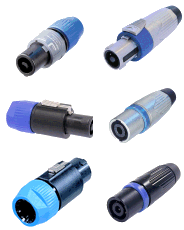SPEAKON SPEAKER CONNECTORS: what are they and why are they used?
 The humble ¼ inch Phone plug and jack are fading from use as a universal speaker connection. While these are fine for the instrument inputs, they simply were not designed for today's high current demands of speaker connections. In fact, phone plug describes their origin: use in telephone switchboards!
The humble ¼ inch Phone plug and jack are fading from use as a universal speaker connection. While these are fine for the instrument inputs, they simply were not designed for today's high current demands of speaker connections. In fact, phone plug describes their origin: use in telephone switchboards! Speakon connectors originated with Neutrik, and you'll find a wide variety of them manufactured by them and some other, compatible variations. They are often referred to as "twist and lock" connectors, but that's a bit outdated as Switchcraft and Neutrik have made versions that are inserted straight in, and lock using a little release tab. When using them for the first time, be sure to determine if the twist and lock motion is necessary to make the connection. The image on the left shows twist and lock examples in the left column, push-in lock on the right.
Speakon connectors originated with Neutrik, and you'll find a wide variety of them manufactured by them and some other, compatible variations. They are often referred to as "twist and lock" connectors, but that's a bit outdated as Switchcraft and Neutrik have made versions that are inserted straight in, and lock using a little release tab. When using them for the first time, be sure to determine if the twist and lock motion is necessary to make the connection. The image on the left shows twist and lock examples in the left column, push-in lock on the right.There are ¼ to Speakon adaptors available, perhaps something to carry as a Plan B if you lose your only cable, but I recommend using Speakons where you can. In my experience, they are quite dependable, and help avoid accidental speaker disconnects. There is also a flavor of Speakon jack that will accept a ¼ inch phone plug or Speakon connector (third one down on the right, a subtle difference). EA used them briefly, but they are not airtight and therefore can leak and even whistle, making them impractical in most high quality speaker cabinets.
But I'm sure you're asking... why is everyone using them? They've got a lot of advantages over ¼ inch phone plugs.
- able to handle higher current.
- conductors are covered, so the danger of getting zapped is eliminated.
- non-shorting, since ¼ inch speaker connections should never be made with the amp on (a good rule in any case) as they can deliver a a brief short to the amp; avoid possible damage by making connections with the amp off.
- self-wiping, so corrosion build-up can be less of a problem... and it sure is down here along the NJ shore! I've actually had speaker cabs "go dead", so I always carry a can of contact cleaner in my gig bag.
- available in 2, 4, and 8 contact versions; this is great for bi-amplified cabinets, for instance, so there is less risk of mixing up woofer and tweeter connections.
